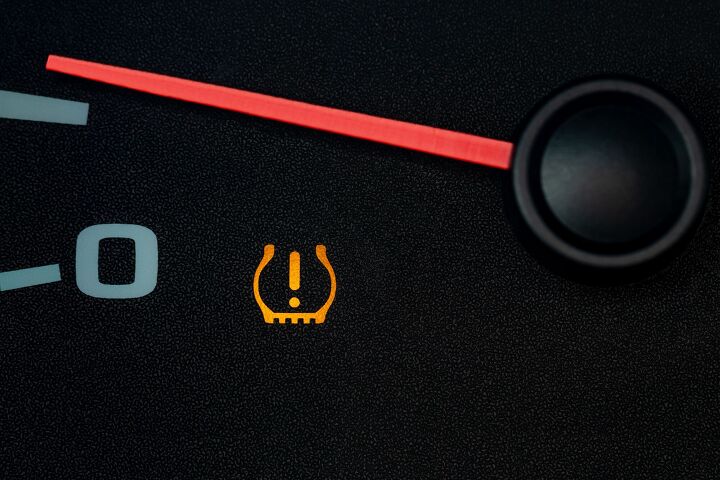Why is My TPMS Light On?

Understanding TPMS
TPMS is an essential safety feature in modern vehicles. Its purpose is to alert drivers when the air pressure in one (or more) of their tires drops significantly below the recommended level. Proper tire pressure is vital for vehicle safety, fuel efficiency, and tire longevity. When your TPMS light comes on, it's the car and the system’s way of telling you that something is amiss with your tires, or possibly the system itself.
Common Reasons for a TPMS Light
There are many reasons that the TPMS light can illuminate, and sometimes that reason is more than one circumstance in conjunction with another; or, one situation (like low tire pressure) is caused by another (like temperature fluctuations). Here are a few common reasons the light comes on:
Low Tire Pressure: The most common reason for a TPMS light to illuminate is low tire pressure. When the PSI in one or more of your tires falls below the recommended minimum and outside the computer’s programmed parameters for what is considered normal, the TPMS sensor triggers the warning light. Low tire pressure can be caused by various factors, including temperature changes, leaks, punctures, simply neglecting to check and maintain tire pressure regularly, and so on.
Temperature Fluctuations: Temperature changes can cause corresponding changes in tire pressure. Cold weather can cause tire pressure to drop, leading to a TPMS warning. This is especially so in severe winter climates where the temperature has dropped significantly from summer temperatures. Conversely, hot weather can increase tire pressure, also prompting the TPMS light. It's essential to be aware of these temperature-related fluctuations and check your tire pressure accordingly. Ideally, the pressure is checked at the start of the season, adjusted in the middle, and again at the end.
Damaged Sensors: The TPMS system relies on electronic sensors in each tire to monitor pressure. These sensors can become damaged or malfunction over time as a result of normal wear and tear. If a sensor is faulty, it may incorrectly trigger the TPMS light even when your tire pressure is normal. Diagnosing and replacing a malfunctioning sensor may be necessary in such cases.
Tire Puncture or Damage: If you've hit a pothole, driven over debris, or have a damaged tire, it could cause a loss of pressure, leading to the TPMS light coming on. In this situation, it's crucial to inspect your tires for visible damage. If you find any, it's best to repair or replace the affected tire as soon as possible. Note that these instances can come by way of slow or fast leaks alike; a tiny nail in the center of a tread block may leak air much more slowly than running over a large piece of spiky metal.
Battery Failure: TPMS sensors have batteries that can wear out over time, just like the sensor themselves. When the batteries fail, the sensors may stop transmitting data, resulting in the TPMS light activating. Replacing the sensor's battery is usually the solution in this case, but if the sensor is older and nearing the end of its projected life, this is a good opportunity to replace the entire sensor as it helps avoid costly labor charges in the future.
Tire Rotation or Replacement: When you rotate or replace your tires, the TPMS sensors may need to be recalibrated. In essence, these changes can mean the sensors either disconnect from or are confused, mandating the car and sensors to relearn the right way to communicate with one another. Failing to do so can lead to a TPMS warning light. Refer to your vehicle's manual or consult a mechanic to ensure proper sensor relearning after tire maintenance.
Why Is the TPMS Light Important?
Understanding why the TPMS light is important is essential for maintaining your vehicle's safety and performance. Here are a few reasons:
Safety: Proper tire pressure is crucial for safe driving. Underinflated tires can affect your vehicle's handling, increase the risk of a blowout, and reduce your ability to stop quickly in an emergency.
Fuel Efficiency: Correct tire pressure ensures optimal fuel efficiency. Underinflated tires create more rolling resistance, which leads to decreased fuel economy. Maintaining the right tire pressure can save you money at the pump and help you go more miles on a tank, meaning less frequent fill-ups.
Tire Longevity: Tires wear more evenly when properly inflated, which leads to longer tire life. Overinflated or underinflated tires wear unevenly, causing costly premature tire replacement.
Handling and Performance: Properly-inflated tires provide better handling and performance. Correct tire pressure ensures your vehicle responds as it should, especially in emergency situations, and allows it to corner with maximum grip. There’s a reason that Formula 1 cars’ tires are frequently checked for optimal tire pressure before a set goes on the car.
What to Do When the TPMS Light Comes On
Don't ignore the TPMS light when it illuminates on your dashboard. Here's what you should do:
Check Tire Pressure: Start by checking the pressure in all four of your tires using a reliable tire pressure gauge. The recommended pressure can usually be found on a sticker in the driver's door jamb or in your vehicle's owner's manual. In some vehicles you may also need to check the PSI in your spare tire, as it too relays its pressure to the car’s computer.
Inflate Tires: If you find that one or more tires are underinflated, inflate them to the recommended pressure. Make sure to use a quality air pressure gauge to get accurate readings, and likewise make sure to check the PSI when the tires are cold (i.e., not immediately after the vehicle has been driven).
Inspect for Damage: Examine your tires for any visible damage. Punctures, cuts, or bulges should be addressed promptly.
Reset TPMS: Some vehicles require a manual TPMS reset after correcting the tire pressure or addressing tire issues. Refer to your owner's manual for specific instructions on resetting the TPMS system.
Replace Sensors: If you suspect a sensor issue or the TPMS light continues to illuminate after addressing the above concerns, it's a good idea to consult a mechanic or dedicated tire shop to diagnose and replace any faulty sensors.
The Tire Pressure Monitoring System (TPMS) is a crucial safety feature in modern vehicles. It’s designed to alert drivers when the pressure in their vehicle’s tires falls below the recommended PSI. When the TPMS light comes on, it's essential to take quick action to ensure the safety of you, your passengers, and the other drivers on the road. Correct tire pressure also helps to maintain fuel efficiency and prolong tire life. Understanding the importance of the TPMS light and knowing how to respond when it illuminates is key to being a responsible and safe, responsible vehicle owner.
Become an AutoGuide insider. Get the latest from the automotive world first by subscribing to our newsletter here.

Ross hosts The Off the Road Again Podcast. He has been in the off-road world since he was a kid riding in the back of his dad’s YJ Wrangler. He works in marketing by day and in his free time contributes to Hooniverse, AutoGuide, and ATV.com, and in the past has contributed to UTV Driver, ATV Rider, and Everyday Driver. Ross drives a 2018 Lexus GX460 that is an ongoing build project featured on multiple websites and the podcast.
More by Ross Ballot




































Comments
Join the conversation